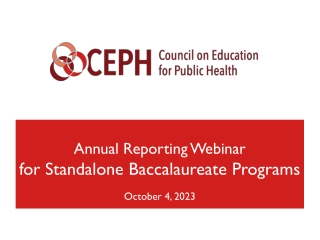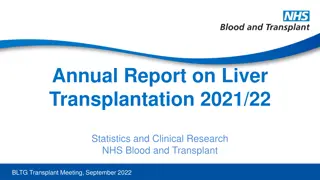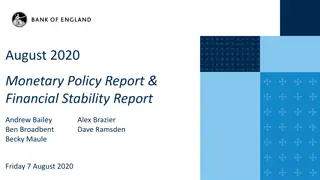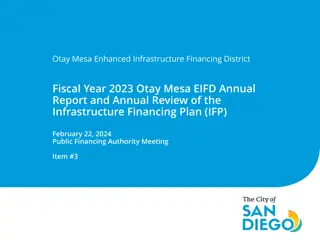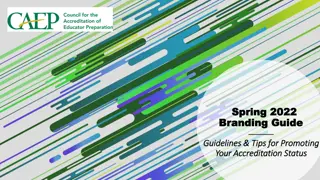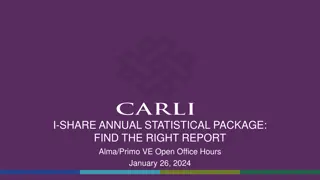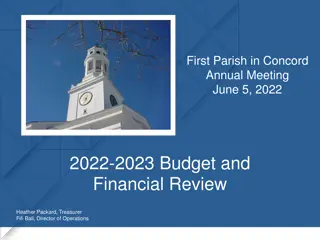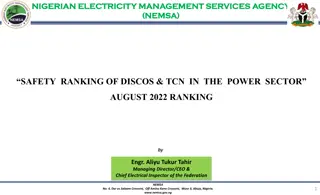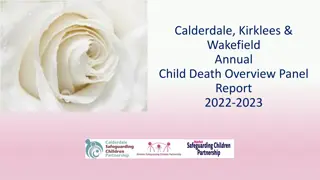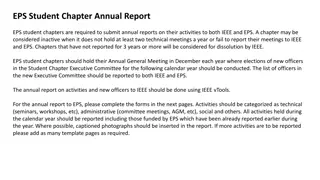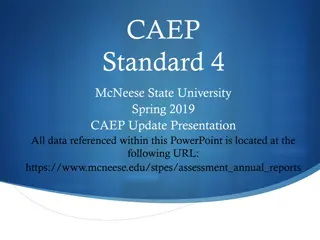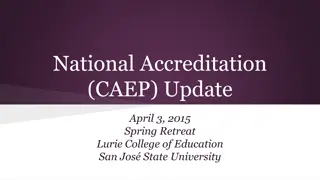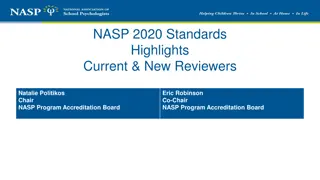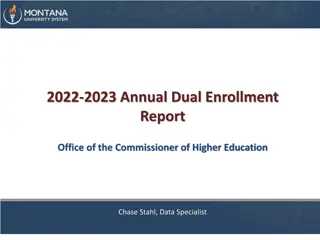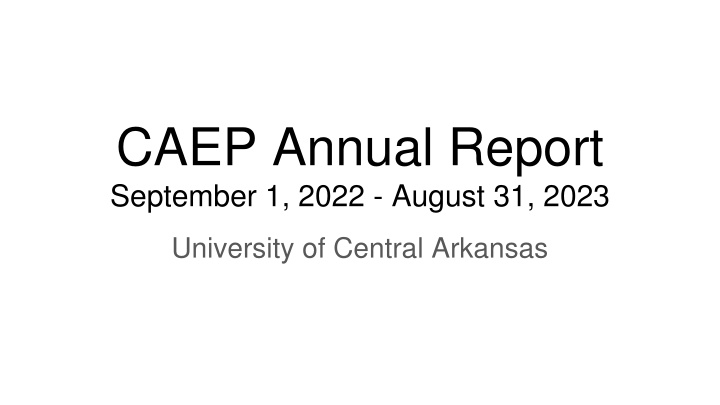
Council for Accreditation of Educator Preparation Annual Report 2022-2023
Explore the University of Central Arkansas' Annual Report for 2022-2023, detailing the completion data, program outcomes, and impact measures required by the CAEP. Discover information on completer effectiveness, employer satisfaction, candidate competency, and hiring rates in both initial and advanced programs.
Uploaded on | 0 Views
Download Presentation

Please find below an Image/Link to download the presentation.
The content on the website is provided AS IS for your information and personal use only. It may not be sold, licensed, or shared on other websites without obtaining consent from the author. If you encounter any issues during the download, it is possible that the publisher has removed the file from their server.
You are allowed to download the files provided on this website for personal or commercial use, subject to the condition that they are used lawfully. All files are the property of their respective owners.
The content on the website is provided AS IS for your information and personal use only. It may not be sold, licensed, or shared on other websites without obtaining consent from the author.
E N D
Presentation Transcript
CAEP Annual Report September 1, 2022 - August 31, 2023 University of Central Arkansas
Overview CAEP (Council for the Accreditation of Educator Preparation) requires the EPP to publicly share data against four annual reporting measures. These measures are used to provide information to the public on both program outcome and program impact on both initial and advanced programs. These data are for the UCA COE in alignment with CAEP annual reporting expectations.
8 Annual Reporting Measures 1. Measure 1 (Initial programs only): Completer effectiveness. Data must address: (a) completer impact in contributing to P-12 student-learning growth AND (b) completer effectiveness in applying professional knowledge, skills, and dispositions. 2. Measure 2: Satisfaction of employers; stakeholder involvement 3. Measure 3: Candidate competency at completion 4. Measure 4: Ability of completers to be hired.
Program Completer Data Academic Year Initial Programs (combined UG and MAT) Advanced Programs 2022-2023 233 205 2021-2022 233 199 2020-2021 288 141 2019-2020 257 124
INITIAL PROGRAMS 2020-2021 2021-2022 2022-2023 K-6 Elementary 117 78 93 4-8 Middle Level 30 26 35 4-12 Business 2 6 1 4-12 Computer Science 1 0 1 7-12 Chemistry * * 3 7-12 English 15 16 7 7-12 FACS 7 11 11 7-12 Life Science 8 3 2 7-12 Math 5 12 7 7-12 Physical Science 1 4 1 7-12 Social Studies 14 9 10 7-12 Speech / Drama 2 0 0 K-12 Art 10 9 9 K-12 Music 23 10 10
ADVANCED PROGRAMS 2020-2021 2021-2022 2022-2023 Building Level Admin 16 22 9 District Level Admin 0 6 2 Curriculum Specialist 1 2 4 Program Specialist - SPED 0 3 0 Library Media 34 22 28 Library Media (Ancillary) * * 2 Reading 3 2 2 Dyslexia 4 6 2 Reading + Dyslexia 16 12 6 School Counseling 26 21 15 Gifted 8 6 5 Instructional Facilitator 3 6 2 ESOL 46 55 Online Teaching and Learning 5 31 29
Measure 1: Completer Effectiveness Completer effectiveness. Data must address: (a) completer impact in contributing to P-12 student-learning growth AND (b) completer effectiveness in applying professional knowledge, skills, and dispositions. INITIAL PROGRAMS ONLY
Measure 1a: Completers Impact on P-12 Learning (AF) Data presented here were secured through partnership with Arch Ford (AF) Novice Teacher (NT) Mentoring Program begun in summer 2017. The AFNT program supports UCA graduates in induction for 3-years post graduation. Districts in the AFNT region support 30-40% of UCA prepared prepared teacher candidates representing all programs across the EPP. All novice teachers in the AFNT program complete an Impact on Student Learning project each March and report data to AF. Data for UCA prepared teachers are compared to the AF aggregate for completers from all other institutions as a benchmark. In 2022-2023, 235 UCA completers in their first three years of service completed the project (Year 1 = 78; Year 2 = 90; Year 3 = 67). Data were representative of all UCA preparation programs with data combined into 5 categories for analysis (Elementary, Middle Level, Secondary, Special Education, MAT). Programs received their data separately. Trend data reflect natural variability in the population and consistent performance relative to the comparative benchmark. UCA prepared completers perform as well as completers prepared at other institutions with no statistical difference noted between groups. The UCA aggregate population scaled score gain x =15.26 compared to the AF aggregate gain of x =15.87. Disaggregated data for completers indicated UCA graduates outperformed their peers in 3 categories: SecED x =15.7, SPED x =14.04 & MAT x =18.84 (p>.05). Completers in 2 categories scored lower than the comparative benchmark: Elem x =15.24; Middle Level x =15.8. Three year trend data indicate MAT candidates prepared at UCA consistently report high student performance scores than their peers prepared at other institutions at a level of statistical significance (UCA x =18.84; AF x =14.17). While differences in elementary, middle level, SecED, and SPED scores compared to their peers is not statistically significant, continued trends around elementary completer performance are persistent and will be a focus of continued analysis. Note: Initial Programs Only
Measure 1b: Completers Teaching Effectiveness (AF) Data presented here were secured through partnership with Arch Ford (AF) Novice Teacher (NT) Mentoring Program begun in summer 2017. The AFNT program supports UCA graduates in induction for 3-years post graduation. Districts in the AFNT region support 30-40% of UCA prepared teacher candidates representing all programs across the EPP. All novice teachers in the AFNT program are observed by their principal and scored on the state-mandated performance observation rubric (Danielson, 2007). Data for UCA prepared teachers is compared to the AF aggregate as a benchmark. Data reported here reflect year 1 novice teachers only. Data were collected in spring/summer 2023. Trends remain consistent for those in the Year 2 and Year 3 cohorts. Domain 1. UCA completers data (x =3.11) were slightly lower than their data for their peers prepared at other institutions (x =3.26). This is not consistent with trends in the previous two years. Differences in data were not statistically significant. Domain 2. UCA completers data (x =3.17) were slightly lower than their data for their peers prepared at other institutions (x =3.29). This is not consistent with trends in the previous two years. Differences in data were not statistically significant. Domain 3. UCA completers data (x =3.11) were slightly lower than their data for their peers prepared at other institutions (x =3.28). This is not consistent with trends in the previous two years. Differences in data were not statistically significant. Domain 4. UCA completers data (x =3.25) were slightly lower than their data for their peers prepared at other institutions (x =3.37). Differences in data were not statistically significant. Note: Initial Programs Only
Measure 2: Satisfaction of Employers UCA Employer Survey - Initial Programs UCA Employer Survey - Advanced Programs
Measure 2: Employer Satisfaction (initial) UCA measures employer satisfaction of program completers through multiple measures including a UCA survey, Arch Ford partner employee survey, and ADE/DESE measure of employer satisfaction. The data presented here were collected through a UCA principal survey aligned to the expectations of the Interstate Teacher Assessment and Support Consortium (InTASC) standards. All data included in the data set were scored on a scale of 1-4 (1 = not prepared, 2 = inadequately prepared, 3 = adequately prepared, 4 = well prepared) with a target score of 3. Faculty in the CAEP Standard 4 committee noted the redesigned survey allowed us to more clearly see a need to support candidates in supporting diverse student populations. Overall trends in Spring 2023 indicate that the EPP is doing well in preparing candidates to for the field with all scores falling in the upper range of the survey (levels 3-4) and exceeding scores from Spring 2022. Relative high points in the data include candidate ability to collaborate with colleagues (x =3.6), ability to align instruction to the Arkansas standards (x =3.58), engagement in ongoing professional learning (x =3.57), ability to meet students needs (x =3.57), technology integration (x =3.56), and content knowledge (x =3.55). These findings are consistent with data from Spring 2022. Relative low points in the data include candidate ability to manage student behavior (x =3.33), multiple methods of assessment (x =3.41), and differentiating instruction (x =3.42). Improvements in data were noted for engaging students in multiple perspectives (x =3.47) and creating inclusive learning environments (x =3.44).
Measure 2: Employer Satisfaction and Milestones (advanced) The data presented here were collected through an employer survey aligned to the expectations of the Council for the Accreditation of Educator Preparation (CAEP) (Standard A.1.1). All data included in the data set were scored on a scale of 1-4 (1 = not prepared, 2 = inadequately prepared, 3 = adequately prepared, 4 = well prepared) with a target score of 3. Overall trends in Spring 2023 indicate that the EPP is doing well in preparing candidates to for the field with all scores falling in the upper range of the survey (levels 3-4) and exceeding scores from Spring 2022 in many criteria. Relative high points in the data included employer ratings around use of technology to support professional practice (x = 3.94), professional skills and content knowledge specific to the professional role (x = 3.78) and professional dispositions (x = 3.76). Relative low points in the data included supporting diverse stakeholders (x = 3.61) which contradicts findings from Spring 2022. Again, while these data points are the relative low spots in the data, all far exceed the benchmark and lie near the well prepared indicator.
Measure 3: Candidate Competency at Completion Praxis Data - Initial Programs Praxis Data - Advanced Programs
Measure 3: Ability of Completers to Meet Requirements Candidate pass rate on required content Praxis exams is tracked across programs by the Office of Candidate Services (OCS). Disaggregated program data are tracked for pass rates, mean score, standard deviation, and range Both initial and advanced programs report overall success in candidate ability to pass the required Praxis content exam(s) with many programs yielding pass rates at 90% and higher. For initial programs, changes to policy for Gate 3 (admission to internship 2) have resulted in higher pass rates, notably for the K6 program. Candidates must now meet the ADE/AAP score for admission to Gate 3 (https://uca.edu/ocs/aap-provisional/). Additionally, the EPP has created several support and remediation structures for students struggling to pass their required exam(s) successfully, including: 240 Tutoring, Praxis Boot Camps (DESE grant), and state resources/tutoring programs. Undergraduate K6 Social Studies continues to be an area of focus for continuous improvement. Access to full reports - https://uca.edu/panda/panda-reports/title-ii-reports/
# # Program Pass Rate State Pass Rate INITIAL UNDERGRADUATE PROGRAMS PROGRAMS Taking Passing 58 50 86 92 K-6 Elementary: Reading & LA 58 53 91 91 K-6 Elementary: Mathematics 58 41 71 85 K-6 Elementary: Social Studies 58 47 81 89 K-6 Elementary: Science 6 * * 51 4-8 Middle Level: ELA 5 * * 94 4-8 Middle Level: Math (5164) 6 * * 95 4-8 Middle Level: Math (5169) 6 * * 87 4-8 Middle Level: Science 11 10 91 82 4-8 Middle Level: Social Studies 4 * * 100 7-12 English 10 6 60 72 7-12 FACS 3 * * 86 7-12 Math 2 * * 100 7-12 Social Studies (5086)
INITIAL MAT PROGRAMS # Taking # Passing Program Pass Rate State Pass Rate 32 32 100 93 K-6 Elementary: Reading and Language Arts 33 32 97 90 K-6 Elementary: Mathematics 33 31 94 82 K-6 Elementary: Social Studies 33 31 94 86 K-6 Elementary: Science 5 * * 67 4-8 Middle Level: ELA 2 * * 50 4-8 Middle Level: Math (5134) 5 * * 81 4-8 Middle Level: Math (5169) 5 * * 83 4-8 Middle Level: Science 2 * * 81 4-8 Middle Level: Social Studies 3 * * 95 7-12 English 2 * * * 7-12 FACS 5 * * 95 7-12 Life Science / Biology 4 * * 69 7-12 Math
ADVANCED PROGRAMS # Taking # Passing Program Pass Rate State Pass Rate 12 11 91.67 93.04 Building Level Administrator (6990) 1 * * 88.89 District Level Administrator (6991) 36 34 94.44 92.50 Library Media (5311) 20 15 75 81.25 Reading (5302) 22 22 100 93.72 School Counseling (5421) 10 9 90 85.88 Gifted (5358) 60 60 100 98.29 ESOL (5362) 9 * * 96.24 Special Education (5354) 7 * * 87.14 Special Education (5511)
Measure 4: Ability of Completers to be Hired ADE Data - Initial Programs Employment Milestones - Advanced Programs
Measure 4: Ability of Completers to be Hired (initial) EPP gathers data on initial program completers employment and retention milestones in partnership with UCA Office of Institutional Research and in partnership with Arkansas Division of Elementary and Secondary Education. Spring 2019 Spring 2020 Spring 2021 Spring 2022 Spring 2023 Completers currently teaching in Arkansas Public Schools 63% 64% 67% 67% 76%
Measure 4: Ability of Completers to be Hired (advanced) EPP gathers data on advanced program completers employment and retention milestones in partnership with UCA Office of Institutional Research 2018-2019 2019-2020 2020-2021 2021-2022 2022-2023 67% 66% 62% 72% 81% Completers currently holding a position in Arkansas Public Schools aligned with their advanced degree obtained

